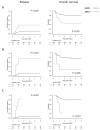Prognostic Impacts of D816V KIT Mutation and Peri-Transplant RUNX1-RUNX1T1 MRD Monitoring on Acute Myeloid Leukemia with RUNX1-RUNX1T1
- PMID: 33477584
- PMCID: PMC7831332
- DOI: 10.3390/cancers13020336
Prognostic Impacts of D816V KIT Mutation and Peri-Transplant RUNX1-RUNX1T1 MRD Monitoring on Acute Myeloid Leukemia with RUNX1-RUNX1T1
Abstract
The prognostic significance of KIT mutations and optimal thresholds and time points of measurable residual disease (MRD) monitoring for acute myeloid leukemia (AML) with RUNX1-RUNX1T1 remain controversial in the setting of hematopoietic stem cell transplantation (HSCT). We retrospectively evaluated 166 high-risk patients who underwent allogeneic (Allo-HSCT, n = 112) or autologous HSCT (Auto-HSCT, n = 54). D816V KIT mutation, a subtype of exon 17 mutations, was significantly associated with post-transplant relapse and poor survival, while other types of mutations in exons 17 and 8 were not associated with post-transplant relapse. Pre- and post-transplant RUNX1-RUNX1T1 MRD assessments were useful for predicting post-transplant relapse and poor survival with a higher sensitivity at later time points. Survival analysis for each stratified group by D816V KIT mutation and pre-transplant RUNX1-RUNX1T1 MRD status demonstrated that Auto-HSCT was superior to Allo-HSCT in MRD-negative patients without D816V KIT mutation, while Allo-HSCT was superior to Auto-HSCT in MRD-negative patients with D816V KIT mutation. Very poor outcomes of pre-transplant MRD-positive patients with D816V KIT mutation suggested that this group should be treated in clinical trials. Risk stratification by both D816V KIT mutation and RUNX1-RUNX1T1 MRD status will provide a platform for decision-making or risk-adapted therapeutic approaches.
Keywords: AML; D816V KIT mutation; RUNX1–RUNX1T1; hematopoietic stem cell transplantation; measurable residual disease.
Conflict of interest statement
The authors declare no competing financial interests.
Figures




Similar articles
-
Prognostic values of D816V KIT mutation and peri-transplant CBFB-MYH11 MRD monitoring on acute myeloid leukemia with CBFB-MYH11.Bone Marrow Transplant. 2021 Nov;56(11):2682-2689. doi: 10.1038/s41409-021-01384-w. Epub 2021 Jun 28. Bone Marrow Transplant. 2021. PMID: 34183780
-
Risk factors for post-transplant relapse and survival in younger adult patients with t(8;21)(q22;q22) acute myeloid leukemia undergoing allogeneic hematopoietic stem cell transplantation: A multicenter retrospective study.Front Oncol. 2023 Feb 9;13:1138853. doi: 10.3389/fonc.2023.1138853. eCollection 2023. Front Oncol. 2023. PMID: 36845681 Free PMC article.
-
Allogeneic hematopoietic stem cell transplantation can improve the prognosis of high-risk pediatric t(8;21) acute myeloid leukemia in first remission based on MRD-guided treatment.BMC Cancer. 2020 Jun 15;20(1):553. doi: 10.1186/s12885-020-07043-5. BMC Cancer. 2020. PMID: 32539815 Free PMC article. Clinical Trial.
-
[Two cases of systemic mastocytosis with RUNX1-RUNX1T1 positive acute myeloid leukemia treated with sequential avapritinib after allogeneic hematopoietic stem cell transplantation and literature review].Zhonghua Xue Ye Xue Za Zhi. 2024 May 14;45(5):505-508. doi: 10.3760/cma.j.cn121090-20240313-00092. Zhonghua Xue Ye Xue Za Zhi. 2024. PMID: 38964927 Free PMC article. Review. Chinese.
-
The Role of Measurable Residual Disease (MRD) in Hematopoietic Stem Cell Transplantation for Hematological Malignancies Focusing on Acute Leukemia.Int J Mol Sci. 2019 Oct 28;20(21):5362. doi: 10.3390/ijms20215362. Int J Mol Sci. 2019. PMID: 31661875 Free PMC article. Review.
Cited by
-
Reduced toxicity (FluBu3) versus myeloablative (BuCy) conditioning in acute myeloid leukemia patients who received first allogeneic hematopoietic stem cell transplantation in measurable residual disease-negative CR1.Bone Marrow Transplant. 2024 Jun;59(6):813-823. doi: 10.1038/s41409-024-02255-w. Epub 2024 Mar 4. Bone Marrow Transplant. 2024. PMID: 38438648
References
-
- Jourdan E., Boissel N., Chevret S., Delabesse E., Renneville A., Cornillet P., Blanchet O., Cayuela J.M., Recher C., Raffoux E., et al. Prospective evaluation of gene mutations and minimal residual disease in patients with core binding factor acute myeloid leukemia. Blood. 2013;121:2213–2223. doi: 10.1182/blood-2012-10-462879. - DOI - PubMed
-
- Marcucci G., Mrozek K., Ruppert A.S., Maharry K., Kolitz J.E., Moore J.O., Mayer R.J., Pettenati M.J., Powell B.L., Edwards C.G., et al. Prognostic factors and outcome of core binding factor acute myeloid leukemia patients with t(8;21) differ from those of patients with inv(16): A Cancer and Leukemia Group B study. J. Clin. Oncol. 2005;23:5705–5717. doi: 10.1200/JCO.2005.15.610. - DOI - PubMed
-
- Schlenk R.F., Benner A., Krauter J., Buchner T., Sauerland C., Ehninger G., Schaich M., Mohr B., Niederwieser D., Krahl R., et al. Individual patient data-based meta-analysis of patients aged 16 to 60 years with core binding factor acute myeloid leukemia: A survey of the German Acute Myeloid Leukemia Intergroup. J. Clin. Oncol. 2004;22:3741–3750. doi: 10.1200/JCO.2004.03.012. - DOI - PubMed
-
- Cher C.Y., Leung G.M., Au C.H., Chan T.L., Ma E.S., Sim J.P., Gill H., Lie A.K., Liang R., Wong K.F., et al. Next-generation sequencing with a myeloid gene panel in core-binding factor AML showed KIT activation loop and TET2 mutations predictive of outcome. Blood Cancer J. 2016;6:e442. doi: 10.1038/bcj.2016.51. - DOI - PMC - PubMed
Grants and funding
LinkOut - more resources
Full Text Sources
Other Literature Sources

